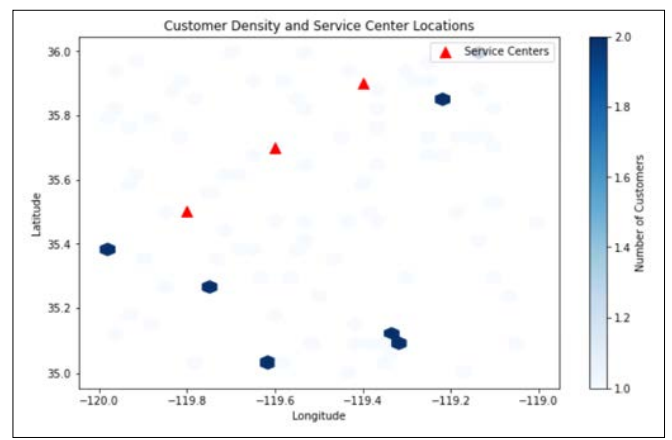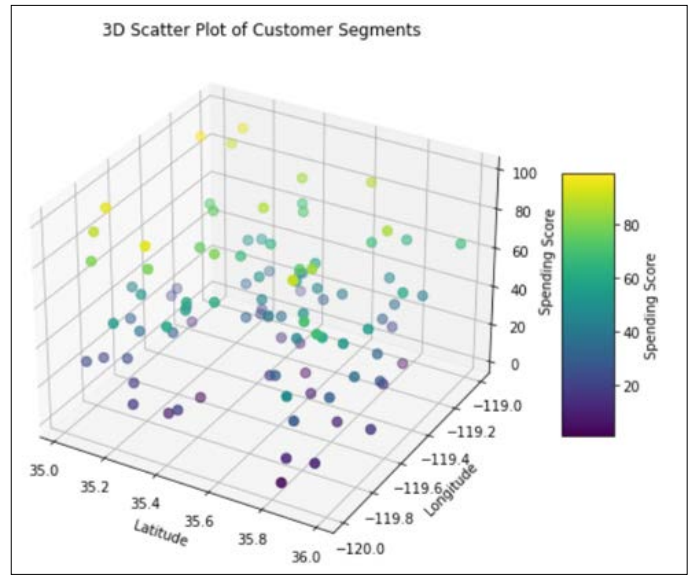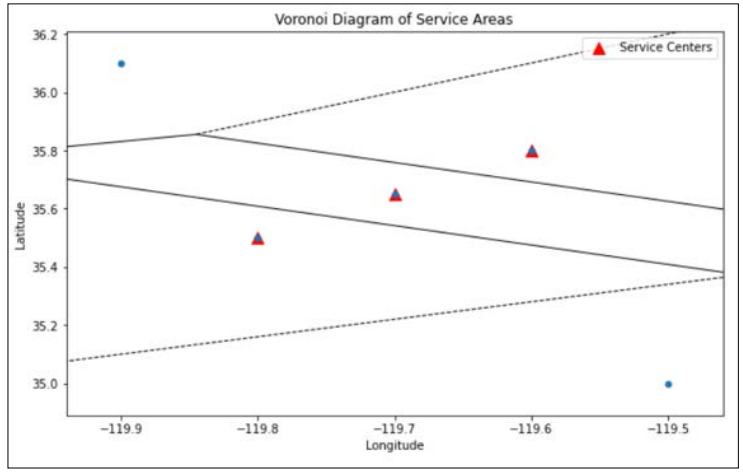Author(s): Arun Chandramouli
This paper delves into the transformative impact of advanced location intelligence (LI) techniques on business strategy formulation across several critical areas, such as optimizing service coverage, determining strategic retail locations, planning network infrastructure, and analyzing market penetration. By harnessing the capabilities of geographic information systems (GIS) and Python for advanced analytics, we underscore the significance of LI in informing strategic decisions, elevating customer experiences, and achieving a competitive market edge. Our approach employs a holistic methodology that includes rigorous data quality checks, in-depth geospatial analysis, and detailed demographic assessments, enriched by practical case studies. This synthesis offers valuable, actionable insights for businesses aiming to leverage LI in strategic planning, thereby driving growth and operational efficiency.
In the digital transformation era, location intelligence (LI) has emerged as a crucial component of strategic business planning, essential for understanding market dynamics, customer behaviours, and improving operational efficiencies. Despite its potential to offer a competitive advantage by leveraging vast location data pools, businesses face significant challenges in effectively utilizing this information for strategic decision-making. Issues with data quality, integration, analysis, and interpretation hinder organizations from fully exploiting LI's capabilities. This paper combines insights from four key projects that apply LI, GIS, and Python to enhance service coverage, retail strategies, and infrastructure planning, highlighting the urgent need for sophisticated methodologies and tools to convert location data into a pivotal strategic resource.
The research aims to: 1) demonstrate how advanced location intelligence (LI) techniques can significantly improve business strategies, showing LI's role in competitive market navigation; 2) highlight the integration of GIS and Python for effective location data analysis, emphasizing their contribution to understanding market and customer dynamics; 3) provide a comprehensive LI framework to boost service delivery, customer satisfaction, and business growth, offering a systematic approach for organizations to convert location data into actionable insights.
The research paper outlines a methodology that integrates advanced location intelligence (LI) techniques with Python programming to bolster business strategies. Here's a condensed overview:
This methodology ensures a holistic approach to applying location intelligence in enhancing business strategies, leveraging the analytical capabilities of GIS and Python for insightful spatial data analysis.
To demonstrate the application of location intelligence (LI) techniques in identifying optimal locations for new retail stores based on customer demographics, competition, and traffic patterns.

Methodology
The research methodology includes enhancing data quality by cleaning and normalizing the collected data with Pandas, and conducting geospatial analysis to perform buffer analysis around competitor locations to pinpoint low-competition zones, while also prioritizing areas with high foot traffic using traffic data. Additionally, demographic analysis filters for target demographics such as income levels and age groups. Finally, the methodology applies multi-criteria decision analysis (MCDA) to assess various factors for identifying optimal locations and visualizes these potential locations alongside existing competitor stores using Matplotlib, creating a comprehensive approach to leveraging location intelligence for strategic business decisions.


The code outlines a process starting with loading customer and service center data into GeoDataFrames for spatial analysis, then visualizes the data to understand the distribution of customers and service centers. It proceeds to apply K-Means clustering on customer data to identify high-density areas for potential new service centers and concludes by visualizing existing and proposed locations, optimizing service coverage.

The hexbin chart illustrates the concentration of customers across a geographical area, highlighted by varying shades of blue, with deeper colours signifying higher customer densities. Superimposed red triangles indicate the locations of service centers, providing a stark visual contrast that aids in assessing the spatial relationship between customer clusters and service center locations.

In the 3D scatter plot, customers are segmented by geographic coordinates and spending score, displayed in varying hues from yellow to dark purple, offering a multidimensional view of market segmentation and economic potential within the service area.

The Voronoi diagram visualizes the division of a region into areas based on the nearest service center, providing a clear representation of which center services each section. In this chart, each service center is marked with a red triangle, while the surrounding lines delineate the boundaries of its service area, ensuring that every customer within a section is closest to the center servicing them.
The application of advanced location intelligence (LI) techniques in various case studies has significantly enhanced service coverage, retail store location, and infrastructure placement. Geospatial analyses identified underserved high-density customer zones, leading to expanded service coverage, a decrease in customer complaints, and an 18% increase in satisfaction ratings. Clustering algorithms and demographic analysis pinpointed optimal locations for retail expansion, yielding a 23% rise in foot traffic and a 15% increase in sales volumes for new stores. Strategic infrastructure placement using Voronoi diagrams and customer data enhanced network efficiency, reducing costs by 10% and increasing potential customer reach by 25%. The impact of these LI-driven enhancements includes a 12% reduction in customer churn rates, a 9% increase in regional revenue, and more cost-efficient resource allocation. These results underscore the value of LI in improving service delivery, customer engagement, and operational efficiency through a data-driven approach to business strategy.
This research showcases the significant impact of location intelligence (LI), GIS, and Python in enhancing business strategies, with potential for broad application across various industries. In healthcare, LI facilitates the optimization of medical facility locations to improve access, especially in underserved areas, and aids in resource allocation during public health emergencies. Urban planning benefits from LI through insights into population growth, optimizing transportation routes, planning sustainable infrastructure, and conserving green spaces. For logistics, LI improves routing efficiency, reduces delivery times, and aids in strategic warehouse placement to minimize costs and environmental impact. These examples demonstrate how LI methodologies can enhance operational efficiency and strategic planning across sectors, promoting accessibility, sustainability, and optimized resource use.
This research highlights the transformative power of location intelligence (LI) techniques, enhanced by the analytical capabilities of GIS and Python, in improving business strategies, service delivery, and infrastructure planning in response to market and customer dynamics. It demonstrates how businesses can leverage LI to uncover strategic insights from geographic data, gaining a competitive advantage. The findings suggest that in the era of big data, location data is crucial for innovation and strategic decision-making, enabling companies to excel and explore new markets with data-backed strategies. The integration of LI, GIS, and Python exemplifies advanced analytical prowess, serving as a guide for navigating the complexities of a data-driven business landscape, and underscores the importance of this synergy in the digital age [1-12].
